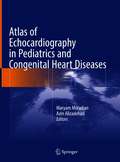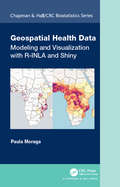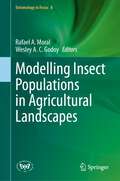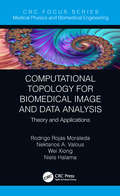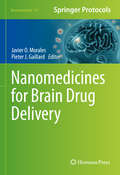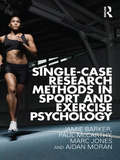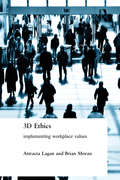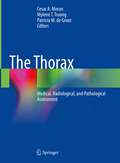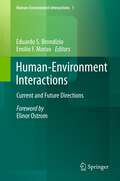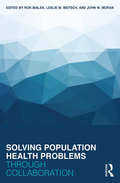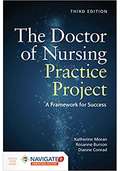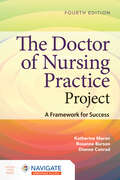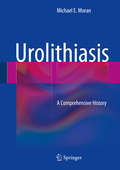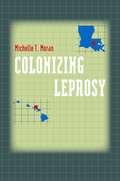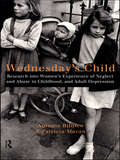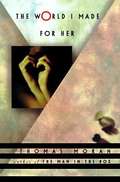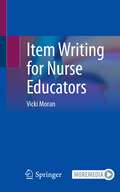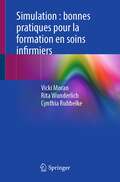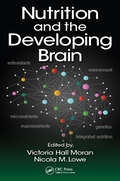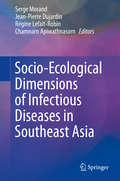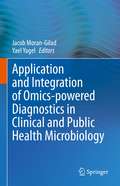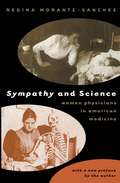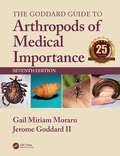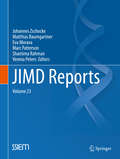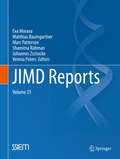- Table View
- List View
Atlas of Echocardiography in Pediatrics and Congenital Heart Diseases
by Maryam Moradian Azin AlizadehaslThis atlas provides a practical guide to the diagnosis of congenital heart disease using echocardiography in both adults and children. A plethora of high-quality echocardiography images provide practical examples of how to diagnose a range of conditions correctly, including aortic stenosis, tricuspid atresia, coronary artery fistula and hypoplastic left heart syndrome. Atlas of Echocardiography in Pediatrics and Congenital Heart Diseases describes the diagnostic management of a range of congenital heart diseases successfully in both adults and children. Therefore it provides a valuable resource for both practicing cardiologists who regularly treat these patients and for trainees looking to develop their diagnostic skills using echocardiography.
Geospatial Health Data: Modeling and Visualization with R-INLA and Shiny (Chapman & Hall/CRC Biostatistics Series)
by Paula MoragaGeospatial health data are essential to inform public health and policy. These data can be used to quantify disease burden, understand geographic and temporal patterns, identify risk factors, and measure inequalities. Geospatial Health Data: Modeling and Visualization with R-INLA and Shiny describes spatial and spatio-temporal statistical methods and visualization techniques to analyze georeferenced health data in R. The book covers the following topics: Manipulating and transforming point, areal, and raster data, Bayesian hierarchical models for disease mapping using areal and geostatistical data, Fitting and interpreting spatial and spatio-temporal models with the integrated nested Laplace approximation (INLA) and the stochastic partial differential equation (SPDE) approaches, Creating interactive and static visualizations such as disease maps and time plots, Reproducible R Markdown reports, interactive dashboards, and Shiny web applications that facilitate the communication of insights to collaborators and policymakers. The book features fully reproducible examples of several disease and environmental applications using real-world data such as malaria in The Gambia, cancer in Scotland and USA, and air pollution in Spain. Examples in the book focus on health applications, but the approaches covered are also applicable to other fields that use georeferenced data including epidemiology, ecology, demography or criminology. The book provides clear descriptions of the R code for data importing, manipulation, modelling, and visualization, as well as the interpretation of the results. This ensures contents are fully reproducible and accessible for students, researchers and practitioners.
Modelling Insect Populations in Agricultural Landscapes (Entomology in Focus #8)
by Rafael A. Moral Wesley A. C. GodoyThis book combines chapters emphasising mathematical, statistical, and computational modelling applied to insect populations, particularly pests or natural enemies in agricultural landscapes. There is a gap between agricultural pest experimentation and ecological theory, which requires a connection to supply models with laboratory, and field estimates and projects receiving inputs and insights from models. In addition, decision-making in entomology with respect to pest management and biological conservation of natural enemies has been supported by results obtained from different computational and mathematical approaches. This book brings contemporary issues related to optimization in spatially structured landscapes, insect movement, stability analysis, game theory, machine learning, computer vision, Bayesian modelling, as well as other frameworks.
Computational Topology for Biomedical Image and Data Analysis: Theory and Applications (Focus Series in Medical Physics and Biomedical Engineering)
by Rodrigo Rojas Moraleda Nektarios A. Valous Wei Xiong Niels HalamaThis book provides an accessible yet rigorous introduction to topology and homology focused on the simplicial space. It presents a compact pipeline from the foundations of topology to biomedical applications. It will be of interest to medical physicists, computer scientists, and engineers, as well as undergraduate and graduate students interested in this topic. Features: Presents a practical guide to algebraic topology as well as persistence homology Contains application examples in the field of biomedicine, including the analysis of histological images and point cloud data
Nanomedicines for Brain Drug Delivery (Neuromethods #157)
by Javier O. Morales Pieter J. GaillardThis volume explores the latest research in central nervous system (CNS) targeted nanocarriers, methods for their synthesis, and its characterization process. Chapters in this book cover topics such as polymeric nanoparticles and liposomes; self-assembled peptide-based scaffolds for lesions of the nervous system; use of peptides as CNS drugs and as potential carriers to optimize brain-targeted delivery; ways to model and assess blood brain barrier absorption of drugs; and the role of neurodegeneration progress of nanomaterials and their potential toxicity concerns. In the Neuromethods series style, chapters include the kind of detail and key advice from the specialists needed to get successful results in your laboratory.Thorough and cutting-edge, Nanomedicines for Brain Drug Delivery is a valuable resource that will help researchers guide and advance the field of nanomedicines for the brain and nervous system.
Single-Case Research Methods in Sport and Exercise Psychology
by Aidan Moran Marc Jones Paul McCarthy Jamie BarkerWhat is single-case research? How can single-case methods be used within sport and exercise? Single-case research is a powerful method for examining change in outcome variables such as behaviour, performance and psychological constructs, and for assessing the efficacy of interventions. It has innumerable uses within the context of sport and exercise science, such as in the development of more effective performance techniques for athletes and sportspeople and in helping us to better understand exercise behaviours in clinical populations. However, the fundamental principles and techniques of single-case research have not always been clearly understood by students and researchers working in these fields. Single-Case Research Methods in Sport and Exercise Psychology is the first book to fully explain single-case research in the context of sport and exercise. Starting with first principles, the book offers a comprehensive introduction to the single-case research process, from study design to data analysis and presentation. Including case studies and examples from across sport and exercise psychology, the book provides practical guidance for students and researchers and demonstrates the advantages and common pitfalls of single-case research for anybody working in applied or behavioural science in a sport or exercise setting.
Three Dimensional Ethics: Implementing Workplace Values
by Brian Moran Attracta LaganEthics is not just about morality; it is a complex dimension of personal and corporate life that can lead to higher performance by both business and society. Customers, employees and business partners seek predictable corporate behaviour that is aligned with stated personal, workplace and democratic values. Ethics training can help to achieve this. This business ethics primer is a valuable tool for raising ethical awareness in your organisation. Reflecting on employees' personal values and world views, it then examines their impact on the development and application of your organisation's mission, vision and values and finally, your organisation's impact on the societies and environment in which it operates. Three Dimensional Ethics: Implementing Workplace Values concludes with a unique chapter on ethics and doing business in China, illuminating roles in corporate stakeholder responsibility that align with principles in the Confucian Analects. Lagan and Moran provide a practical perspective on business ethics training that is lively, relevant and useful with insights into managing corporate values such as: Ethical frameworks Ladder of escalation options Ethical dilemmas Ethical decision making models Ethics audits Codes of ethics and Codes of conduct Vision and values models Stakeholder commitment steps Governance checklists Addressing values gaps Knowing your values The four virtues Stages of moral development Reflection and action Training tools include Australian and global case studies, definitions, tips, snapshots of ethical approaches, models, quotes, checklists, discussion panels, workshops, scenarios and exercises.
The Thorax: Medical, Radiological, and Pathological Assessment
by Cesar A. Moran Mylene T. Truong Patricia M. de GrootThe current medical practice has become more of a team effort rather than an isolated practice. The current evaluation of patients in the daily practice is essentially performed by medical assessment of the patient in question followed by diagnostic imaging, and when needed and possible the evaluation of tissue for diagnosis with its subsequent assessment of biomarkers and other ancillary tools that play an important role in the evaluation and prognosis. The book herein proposed will exactly provide such assessment focused in the thoracic assessment of patients afflicted with any particular disease of the thorax. Expert clinician in pulmonary medicine will provide the state of the art in the evaluation of such patients, which will provide the most important background in the clinical impression and further assessment of these patients. This assessment in most cases is followed by the evaluation of imaging, which provides a highly important information of not only the exact location of the process but also of the nature of whether is localized, infiltrative, diffuse, bilateral, etc., as well as the possible compromise of other adjacent structures. Such information is crucial as imaging and clinical information will provide a working diagnosis, which ultimately will be defined by the pathological assessment. Therefore, in real practice neither one of these subspecialties works alone or in isolation. On the contrary, each one depends on the other for the final diagnosis and proper management of patients with thoracic diseases. Based on such experience is that the current text will provide in the same text of the needed information that a clinician, radiologist or pathologist will need in order to arrive to the best possible conclusion. The scope of this book is unique in its nature as currently, even though there are several text on either one of those specialties, those publication are strictly on the either radiology, medicine or pathology. Our proposed text will bring all those together in a single text and written by experts in their respective field. This book should be of interest to all of those in the practice of thoracic medicine (radiologist, pulmonologist, pathologists) and any one who in the general practice is confronted with the evaluation of these patients.
Human-Environment Interactions
by Emilio F. Moran Eduardo S. BrondízioDrawing on research from eleven countries across four continents, the 16 chapters in the volume bring perspectives from various specialties in anthropology and human ecology, institutional analysis, historical and political ecology, geography, archaeology, and land change sciences. The four sections of the volume reflect complementary approaches to HEI: health and adaptation approaches, land change and landscape management approaches, institutional and political-ecology approaches, and historical and archaeological approaches.
Solving Population Health Problems through Collaboration
by John W. Moran Leslie M. Beitsch Ron BialekRapid changes in healthcare and public health offer tremendous opportunities to focus on process improvement. Public health departments and agencies increasingly work collaboratively with hospitals and other community partners to promote knowledge and improve collective impact through public and private sector coalitions. Solving Population Health Problems through Collaboration brings together population health experts and leaders to examine evidence-based intervention strategies, case studies in health departments and hospitals, health equity issues, core competencies, public health campaigns, step-by-step collaboration advice, and much more. Each chapter is written by a population health leader shaped by his or her experience implementing change in a community’s health, to demonstrate innovative methods and tools for building and leading sustainable community coalitions to effect real change. Designed to prepare population health workers in public health and healthcare settings to develop strategies for improved population health, this book is required reading for public health managers and health administrators as well as students enrolled in population health courses.
The Doctor of Nursing Practice Project: A Framework For Success
by Katherine J. Moran Rosanne Burson Dianne ConradThe Doctor of Nursing Practice Project: A Framework for Success, Third Edition provides the foundation for the scholarly process enabling DNP students to work through their project in a more effective, efficient manner. The Third Edition is intended for practical application and remains focused on the scholarly project. In addition, it specifically outlines how the project has been used to prepare clinical scholars for practice, a focus seen nationally. A new chapter on health policy highlights the DNP core competencies that are used to advocate for healthcare policy change. This chapter covers how policy impacts practice, how the DNP nurse is the leader of the profession, their role as it relates to advocacy, the connection of the DNP project and health policy and concludes with an action plan. Coverage of the scholarly project tools and exemplars which highlight the variety of work by DNP nurses are also found throughout the text.
The Doctor of Nursing Practice Project: A Framework for Success
by Katherine J. Moran Rosanne Burson Dianne ConradThe Doctor of Nursing Practice Project: A Framework for Success, Fourth Edition provides a road map and toolkit for students to use on their DNP scholarly project journey, starting from conception through completion and dissemination. With a focus on key information for planning, implementing, and evaluating a project, the text also emphasizes the impact that DNP-prepared nurses and well-developed DNP projects have in shaping the future of nursing and healthcare. The Fourth Edition has been thoroughly revised and updated to incorporate the new AACN Essentials and provides greater clarity on the current state of DNP project work. This practical resource features new content on sustainability, knowledge networks, sequential projects, the need for business acumen, financial analysis and implications, the need to work with stakeholders, as well as the need to use data to validate the problem.
Urolithiasis
by Michael E. MoranUrolithiasis: A Comprehensive History provides a historical sojourn into the varied manifestations of kidney stone disease. Utilizing historical sources and integrating classic material with new concepts, this new volume provides depth and details on stone disease not found in modern overviews on the topic. This volume serves as a very useful tool for physicians and researchers dealing with kidney stone disease. Written by a renowned expert in the field, Urolithiasis: A Comprehensive History is an in depth resource that heightens our medical understanding of this ancient disease and is of great value to urologists, nephrologists, endocrinologists interested in stone disease.
Colonizing Leprosy
by Michelle T. MoranBy comparing institutions in Hawai'i and Louisiana designed to incarcerate individuals with a highly stigmatized disease, Colonizing Leprosy provides an innovative study of the complex relationship between U.S. imperialism and public health policy in the late nineteenth and early twentieth centuries. Focusing on the Kalaupapa Settlement in Moloka'i and the U.S. National Leprosarium in Carville, Michelle Moran shows not only how public health policy emerged as a tool of empire in America's colonies, but also how imperial ideologies and racial attitudes shaped practices at home.Although medical personnel at both sites considered leprosy a colonial disease requiring strict isolation, Moran demonstrates that they adapted regulations developed at one site for use at the other by changing rules to conform to ideas of how "natives" and "Americans" should be treated. By analyzing administrators' decisions, physicians' treatments, and patients' protests, Moran examines the roles that gender, race, ethnicity, and sexuality played in shaping both public opinion and health policy. Colonizing Leprosy makes an important contribution to an understanding of how imperial imperatives, public health practices, and patient activism informed debates over the constitution and health of American bodies.
Wednesday's Child: Research into Women's Experience of Neglect and Abuse in Childhood and Adult Depression
by Patricia Moran Antonia BifulcoAs many as one in four women have suffered severe neglect or abuse in childhood. This doubles the likelihood of their suffering clinical depression in adult life. Based on twenty years of systematic research,Wednesday's Child examines why neglect and abuse occur and demonstrates how such negative experience in childhood often results in abusive adult relationships, low self-esteem and depression. Drawing on interviews with over 200 women, the authors show vividly what can be learned from the experience of adult survivors of abuse. Most importantly, Wednesday's Child assesses the factors which can reduce the later impact of such experience on both the children of today and the parents of tomorrow.
The World I Made For Her
by Thomas MoranJames Blatchley breathes and eats through tubes, slipping in and out of a coma. Nuala is the Irish immigrant nurse who coaxes him toward survival. The odd synergy of their relationship is both his link to reality and his inspiration to fantasy. This is the hypnotic story of the world that grows in the silence between them. In Thomas Moran's first novel, the New York Times Book Review saw evidence of his "incontestable conceptual gifts". In his "elegant writing", the Los Angeles Times found the promise of a serious new career. The New Yorker compared The Man in the Box to The Diary of Anne Frank, and the Los Angeles Times compared Thomas Moran to Eli Wiesel. And on the heels of this critical success comes The World I Made for Her. Nuala means "white shoulders" in Gaelic. Nuala's wild red hair falls in disarray over hers. James watches her moving deftly around him; changing his IV, attaching a fresh respirator tube. Nuala's movements are like dance to him through his morphine-clouded vision. His senses are numbed, his mind is dulled, but he hears her Irish spirit sing against the metronome of the life-support machines. He is drawn to the warmth of her. He carries Nuala in and out of consciousness with him, writing a secret love story in which she is, unknowingly, the heroine. In prose that moves seamlessly between fantasy and reality, The World I Made for Her is a novel of obsession and redemption that unfolds like a dream -- a story that will break your heart.
Item Writing for Nurse Educators
by Vicki MoranThe book provides guidance and direction for any nurse educator teaching in the professional environment and must write questions to evaluate learning. It covers the basics of item writing and leveling of items using Bloom's taxonomy to the learner. In addition, the book provides stem examples and new types of questions expected on the National Council Licensure Examination for both the registered and practical nurse. Finally, case study development and item analysis are presented.Evaluation of student performance by examination is critical in nursing education, from undergraduate to continuing education programs. Many faculty have reported learning the item writing process in graduate programs, but it is often lost or not reused. Recent research reports nursing faculty using textbook questions that have not been validated and security of the questions have been compromised. A nursing education profession should have the ability to develop items to validate that learning has occurred. The skill is essential to any professional to evaluate the effectiveness of learning.Critical thinking is a skill necessary for licensure examinations, and students often need assistance to learn this skill to pass the licensure examination and practice as a nurse. Therefore, faculty need a source to facilitate their development of the learned item writing process to assist learners and prepare them for practice.This book is unique in that it addresses the basics and the advanced components. In addition, the book provides a substantial list of stems and case study ideas. Finally, the book describes how to use a knowledge-based item and develop an item to a higher level of Blooms' taxonomy and assists those nursing programs that educate international students to adequately prepare for the student to pass the national licensing examination required to practice in the US and Canada.
Simulation : bonnes pratiques pour la formation en soins infirmiers
by Vicki Moran Rita Wunderlich Cynthia RubbelkeCe livre présente les normes fondées sur les preuves pour l’enseignement de la simulation en soins infirmiers. Le principe fondamental de l'excellence et de la pertinence de la simulation en soins infirmiers est détaillé tout au long de l'ouvrage. Il aborde également les éléments nécessaires à une simulation de qualité, de son développement à sa mise en œuvre. Ces domaines (non exhaustifs) incluent le contexte théorique, l'accréditation et normes d'homologation, l'environnement, le développement et la mise en œuvre de différents types de simulations et enfin le débriefing. Ces domaines sont décrits sur la base d’un examen approfondi de la littérature et des pratiques actuelles proposées par l'International Nursing Association for Clinical Simulation and Learning (INACSL), la Society for Simulation in Healthcare (SSH), la National League for Nursing (NLN) et les State Boards of Nursing (USA). Cet ouvrage deviendra rapidement un guide de référence pour de meilleures pratiques de la simulation dans l'enseignement des soins infirmiers.
Nutrition and the Developing Brain
by Victoria Hall Moran Nicola M. LoweNutrients play a significant role in brain development throughout fetal and postnatal life. This book reviews the evidence from animal and human research, highlighting the influence of specific nutrients on brain function and cognitive development. With a unique, integrative approach to the nutritional, environmental, and genetic influences on brain development, the book examines issues such as single versus multiple limiting nutrients, critical periods of deficiency, and the impact of the child-parent relationship on the architecture of the developing brain. <P><P>The effect of undernutrition on the developing brain of infants and young children can be devastating and enduring. It can impede behavioural and cognitive development and educability, thereby undermining future work productivity. Chapter authors are experts in this field of research and provide an up-to-date insight into the role of the individual nutrients in brain development and function.
Socio-Ecological Dimensions of Infectious Diseases in Southeast Asia
by Serge Morand Jean-Pierre Dujardin Régine Lefait-Robin Chamnarn ApiwathnasornThis book pursues a multidisciplinary approach in order to evaluate the socio-ecological dimensions of infectious diseases in Southeast Asia. It includes 18 chapters written by respected researchers in the fields of history, sociology, ecology, epidemiology, veterinary sciences, medicine and the environmental sciences on six major topics: (1) Infectious diseases and societies, (2) Health, infectious diseases and socio-ecosystems; (3) Global changes, land use changes and vector-borne diseases; (4) Monitoring and data acquisition; (5) Managing health risks; and (6) Developing strategies. The book offers a valuable guide for students and researchers in the fields of development and environmental studies, animal and human health (veterinarians, physicians), ecology and conservation biology, especially those with a focus on Southeast Asia.
Application and Integration of Omics-powered Diagnostics in Clinical and Public Health Microbiology
by Jacob Moran-Gilad Yael YagelVarious “omics” methods have recently revolutionized molecular diagnostics. Next-generation sequencing (NGS) makes it possible to sequence a human genome in just one day. Whole genome sequencing (WGS) greatly improves the ability to investigate the outbreaks of numerous pathogens. Metagenomics helps to analyze the microbiome, which aids greatly in identifying the pathogenesis of infectious diseases. Proteomic-based methods, namely matrix-assisted laser desorption-ionization time of flight mass spectrometry (MALDI-TOF-MS), have a promising role in identifying myctobacteria and fungi, and predicting antimicrobial resistance. While there are numerous scientific publications on “omics” applications for microbiology, there are relatively few books that review this topic from a clinical diagnostics perspective. This book looks at this field from a holistic viewpoint, instead of limiting by type of “omics” technology, in order to cover the body of knowledge needed for practitioners and academics interested in clinical and public health microbiology. Additionally, it addresses the management, economical, regulatory and operational aspects of integrating these technologies into routine diagnostics.
Sympathy and Science
by Regina Morantz-SanchezWhen first published in 1985, Sympathy and Science was hailed as a groundbreaking study of women in medicine. It remains the most comprehensive history of American women physicians available. Tracing the participation of women in the medical profession from the colonial period to the present, Regina Morantz-Sanchez examines women's roles as nurses, midwives, and practitioners of folk medicine in early America; recounts their successful struggles in the nineteenth century to enter medical schools and found their own institutions and organizations; and follows female physicians into the twentieth century, exploring their efforts to sustain significant and rewarding professional lives without sacrificing the other privileges and opportunities of womanhood. In a new preface, the author surveys recent scholarship and comments on the changing world of women in medicine over the past two decades. Despite extraordinary advances, she concludes, women physicians continue to grapple with many of the issues that troubled their predecessors.
The Goddard Guide to Arthropods of Medical Importance
by Gail Miriam Moraru Jerome Goddard IICovering all major arthropods of medical importance worldwide, this award-winning resource has established itself as a standard reference for almost 25 years. With the globilization of commerce and the world becoming more intimately connected through the everyday ease of travel, unknown arthropod species are being increasingly encountered. This means access to up-to-date, authoritative information in medical entomology has never been more important. Now in its seventh edition, this book maintains its well-acclaimed status as the ultimate easy-to-use guide to identify disease-carrying arthropods, the common signs and symptoms of vector-borne diseases, and the current recommended procedures for treatment. Includes an in-depth chapter with diagnostic aids to help physicians to recognize and accurately diagnose arthropod-related diseases and conditions more easilyUpdates all chapters with the latest medical and scientific findings, including Zika virus, red meat allergy, new viruses found in ticks, and vaccine development for malaria and dengue feverPresents a greater medical parasitology emphasis throughout Offers electronic downloads containing additional photographs of arthropod-caused diseases and lesions, as well as instructional videos with pest identification aids, basic entomology, and insect and pest ecology.Illustrated throughout with detailed color images to aid identification, The Goddard Guide to Arthropods of Medical Importance, Seventh Edition will remain an essential guide for physicians, public health officials, and pest control professionals.
JIMD Reports, Volume 25
by Eva Morava Matthias Baumgartner Marc Patterson Shamima Rahman Johannes Zschocke Verena PetersJIMD Reports publishes case and short research reports in the area of inherited metabolic disorders. Case reports highlight some unusual or previously unrecorded feature relevant to the disorder, or serve as an important reminder of clinical or biochemical features of a Mendelian disorder.
JIMD Reports, Volume 25
by Eva Morava Matthias Baumgartner Marc Patterson Shamima Rahman Johannes Zschocke Verena PetersJIMD Reports publishes case and short research reports in the area of inherited metabolic disorders. Case reports highlight some unusual or previously unrecorded feature relevant to the disorder, or serve as an important reminder of clinical or biochemical features of a Mendelian disorder.
